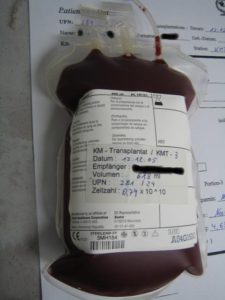
Recently Diagnosed or Relapsed? Stop Looking For a Miracle Cure, and Use Evidence-Based Therapies To Enhance Your Treatment and Prolong Your Remission
Multiple Myeloma an incurable disease, but I have spent the last 25 years in remission using a blend of conventional oncology and evidence-based nutrition, supplementation, and lifestyle therapies from peer-reviewed studies that your oncologist probably hasn't told you about.
Click the orange button to the right to learn more about what you can start doing today.
- You are here:
- Home »
- Blog »
- Multiple Myeloma »
- Myeloma Chemotherapy-Velcade, Revlimid, Dex- MRD-, STOP!
Myeloma Chemotherapy-Velcade, Revlimid, Dex- MRD-, STOP!

“Similarly, the rates of undetectable MRD at a threshold of 3 x 10-6 increased from 28.8% after (MM) induction to 42.1% after transplant and 45.2% after consolidation.”
According to the article linked and excerpted below, approximately 29% of patients who undergo the triple induction multiple myeloma chemotherapy regimen of Velcade, Revlimid and Dex. will achieve minimal residual disease (MRD) after six cycles of therapy.
Further, autologous stem cell transplants (ASCT) aka high-dose chemotherapy cause short, long-term and late stage side effects. I know because I had an ASCT in December of 1995.
It is possible that late stage side effects from your ASCT won’t make themselves known until years after your active therapy. My chemotherapy-induce atrial fibrillation didn’t occur for years after my therapy. My nerve damage didn’t really take hold, also, for years after my therapies.
My point is not to sound angry about stem cell transplants but to sound cautious about your therapy plan.
If you are one of the fortunate 29% of MM patients who undergo VRd induction therapy and achieve MRD before your ASCT, please, please, please ask your oncologist if more high-dose, aggressive chemotherapy will reduce your MM further.
I mean, MRD means ONE myeloma cell for every 1 MILLION healthy bone marrow cells. I don’t think you can get much better than MRD -. Studies show that MRD- leads to longer overall survival (OS). This is length of life. MRD- is the point, not how much toxicity you sustain.
Again, don’t take my word for it. Ask your oncologist. At the very least harvest and freeze your stem cells and wait to have your ASCT later, if need be.
If you achieve an excellent response to your multiple myeloma chemotherapy, consider evidence-based but non-toxic therapies after you have completed your active MM chemotherapy. Nutrition, supplementation, various lifestyle therapies have been shown to be cytotoxic (kill) multiple myeloma.
I have maintained my own MM remission since early 1994 by living an evidence-based but non-toxic anti-MM lifestyle.
Have you been diagnosed with multiple myeloma? What stage? What is your therapy plan? Scroll down the page, post a question or comment and I will reply to you ASAP.
Hang in there,
David Emerson
- MM Survivor
- MM Coach
- Director PeopleBeatingCancer
Recommended Reading:
- Multiple Myeloma, Sex and an ASCT
- MRD After MM Induction- Don’t Need ASCT?
- Multiple Myeloma- Newly Diagnosed Without Intent to ASCT
- Probiotic Prehabilitation for Multiple Myeloma Induction Therapy Improves Outcomes
Measurable (minimal) residual disease
“Minimal residual disease (MRD) is the name given to small numbers of leukaemic cells (cancer cells from the bone marrow) that remain in the person during treatment, or after treatment when the patient is in remission (no symptoms or signs of disease)…”
Triple-Drug Induction Therapy Yields Sustained Responses in Multiple Myeloma
“According to results from a study published in Blood, the 3-drug combination of bortezomib, lenalidomide, and dexamethasone (VRD) as induction therapy prior to autologous stem cell transplant (ASCT) is highly effective at achieving and maintaining high-quality responses in patients with multiple myeloma (MM)…
The researchers focused on a secondary end point, depth of response (complete response [CR] and measurable residual disease (MRD) throughout induction, ASCT, and consolidation, and evaluated safety during induction.
Patients, who were 65 years or younger, were administered 6 cycles of VRD, with each 28-day cycle consisting of lenalidomide given from day 1 to 21; subcutaneous bortezomib given on days 1, 4, 8, and 11; and dexamethasone given on days 1 to 4 and 9 to 12.
After 6 induction cycles, the CR rate was 33.4% and undetectable MRD rates were 28.8% and 47.4% at median thresholds of 3 x 10-6 and 3 x 10-4, respectively. Over time, responses deepened; in patients who had started cycle 6, the rates of very good partial response or better were 55.6% by cycle 3, 63.8% by cycle 4, 68.3% by cycle 5, and 70.4% after induction. Similarly, the rates of undetectable MRD at a threshold of 3 x 10-6 increased from 28.8% after induction to 42.1% after transplant and 45.2% after consolidation.
- During induction, neutropenia (12.9%) and infection (9.2%) were the most common grade 3 or higher treatment-emergent adverse events.
- The rate of grade 2 or higher peripheral neuropathy was 17.0% (grade 3, 3.7%; grade 4, 0.2%).
- Treatment was discontinued in 14 patients (3.1%), and 9 patients (2.0%) died due to treatment-emergent adverse events.
Disclosures: Some authors have declared affiliations with the pharmaceutical industry. Please refer to the original study for a full list of disclosures.
Reference
1. Rosiñol L, Oriol A, Rios R, et al. Bortezomib, lenalidomide, and dexamethasone as induction therapy prior to autologous transplant in multiple myeloma [published online, October 17, 2019]. Blood. doi:10.1182/blood.2019000241



